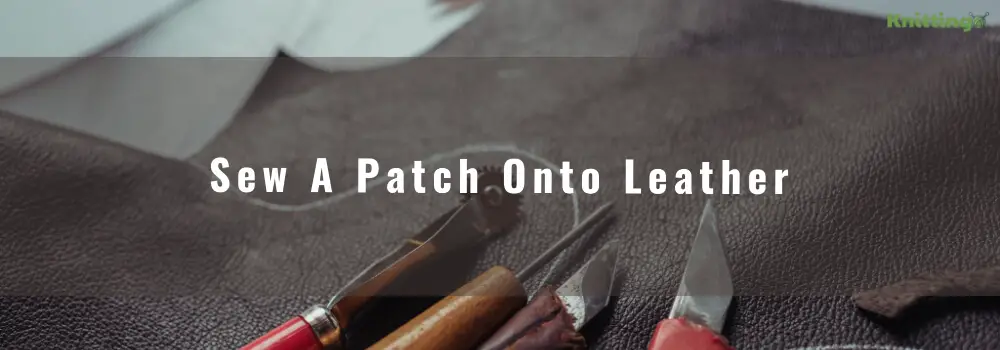Leather is a very tough material even when compared with denim and virtually indestructible in our daily lives. That’s why motorists wear it to protect themselves while riding from rock, road debris, and dust. But often, we see these leather jackets with patches stuck in different places. Embroidery patches are a great way to decorate your leather cloth to add extra flair and stand out from the rest. They are placed differently, and we will discuss how to sew patches using a sewing machine and stitching by hand.
The patches are also used to convey a message like your affiliate organization. That’s why it’s significant to understand how to apply your patches onto leather correctly to avoid ruining it. Since leather is tough, you need more effort to poke a needle through when stitching patches by hand. If it’s a one-time thing, sewing by hand is the best choice, but when you plan to sew many patches, you should consider using a sewing machine.
Remember, sewing leather can weaken your materials, and there is a possibility of it no longer being waterproof. Since leather is a durable material, it’s advisable to sew patches using the fishing line. When you use a cotton thread, there is a possibility leather will outlast your sewing, meaning it will not keep it looking nice. Keep reading and find out more tips for sewing patches onto the leather.
How Can I Sew A Patch Onto Leather?
For leather patch sewing, you can either sew by hand or use a regular machine. Sewing a patch by hand is suitable for a one-time task. But for a stack of patches, it is best to use a sewing machine.
How Can I Sew A Patch On Leather By Hand?
Sewing a patch by hand is the most traditional way, although it provides the highest sense of accomplishment at the end. It will take you between twenty to thirty minutes to sew every patch onto the leather. The items you need to accomplish the task are scissors, thread, tape, safety pin, patch, and needle. Once you have them, follow these steps below:
Step1: Place A Rolled-Up Tape Piece On The Back Of Your Patch
You will need a piece of tape to roll it into a loop and ensure the sticky side is out. You can either use masking tape or scotch tape but not double-sided tape since it can get sticky on your leather. Carefully place the tape in the back of your patch. It will keep the patch in place as you sew it on. However, you should remove the tape before you finish sewing the patch. In case you’re using pins, make sure it’s in the midst of the patch. At least five pins or more is enough to accommodate a large patch.
Step 2: Place The Patch Onto A Leather Cloth Where You Want It To Be
Place the patch depending on your taste or your company’s preferences. It can be placed on the leather on a specific side, be it the back or front side. If you use adhesive spray, you need to wait for a few seconds to allow the glue to get tacky.
Step 3: Unstitch A Gap On Your Leather Cloth If Needed
The exciting thing about sewing by hand is that you have the chance to make a hole in the lining that your hands fit through. To undo the stitching on the lining in the area, you need to place the patch using a seam ripper. Ensure the hole is big enough to allow your hand to fit in easily. But if your leather cloth doesn’t have the lining, skip this step, or if removing the lining stitch will ruin it.
Step 4: Use 100% Nylon Or Polyester Thread For A Leather Needle
Pick a transparent thread and if possible, choose a color that complements the outer border of your patch. Be sure that the strand is 100% nylon or polyester. Using cotton thread will degrade over time while your leather is still intact. You should knot the thread after threading the needle. Be aware that leather needles have a certain point; instead of having a conical shape, they have a pyramid or triangular shape. You can find those needles and thread in fabric or craft shops.
Step 5: Thrust Your Needle Up Through The Leather And The Patch
Thrust the needle up through your leather back and out through the front side of the patch. Even though it doesn’t matter where you start sewing, it’s much easier to start in a corner. Try as possible to get the needle inside the embroidery border of the patch. You can choose to use a thimble for your delicate skin on your finger to avoid piercing.
Step 6: Thrust The Needle Back Across The Leather, Close To Your Patch.
Put the needle on top of your leather, right close to the outer border of the patch. Thrust the needle across the leather, and pull on it to tightened the stitch. With that, you would have completed the first whipstitch. Running stitch can also be used though it may have visible inside the border while whipstitch is visible.
Step 7: Whipstitch Or Running Stitch A Third Way Around The Patch
Continue to whipstitch or running stitch around the patch up to a third way, then keep your stitches small, tight, and close to each other. However, if you are using adhesive, this step is not necessary.
Step 8: Remove Safety Pins Or The Tape Underneath
After sewing a third of the patch, pose and slide your fingers across the gap under to remove the tape. Skip the step if you are using adhesives.
Step 9: Finish Sewing The Patch
Finish sewing around your patch, and make sure the last stitch is on the backside of your leather. Knot the thread tightly and snip off the excess. You should knot the strand to the first stitch you made if you didn’t undo the lining.
Step 10: Sew Back The Lining Using A Ladder Stitch
Thread your needle, and then make a knot at the end. Afterward, push it back of your lining, then out on the front side, close to the folded border of your seam. Sew the second seams together using a ladder stitch. When you are done, knot and snip your thread. If you did not undo the lining, skip this step.
How Can You Patch Onto The Leather Using A Sewing Machine?
Using a sewing machine is the most efficient, fastest, and secure way to patch up your leather cloth with gorgeous designs. But you can only sew patches on specific areas, unlike the manual method. All the same, it’s the most effective and suitable method to sew a stack of patches onto your leather within the shortest time possible, i.e., five minutes on each patch.
Don’t worry if you don’t have a leather sewing machine, since you can use your heavy-duty machine too. In this case, you need scissors, thread, patches, safety pins or adhesives, leather cloth, and a sewing machine. For better understanding, follow these steps:
Step1: Set your sewing machine first and thread with 100% polyester or nylon upholstery. Adjust the tension thread and length as well as machine settings for handling leather. A sharp leather needle is more suitable to tackle leather materials. Avoid using cotton threads as they will degrade quickly.
Step 2: Attach the patch to your suitable location using safety pins or spray adhesives. But if you are using the latter, be sure to apply an even, light mist. This keeps the patch in the proper position as you stitch, but you can use a glue stick or rubber cement as well.
Step 3: Sew the patch onto your leather; you can start at one of the corners. Go slowly around the curves. When you reach a corner, push the needle down, lift the foot, rotate your cloth before resuming, push the foot back.
Step 4: If you are sewing a circular patch, turn it along with your cloth as you stitch close to the patch border. Whereas for straight edges, sew them straightly to the first corner. Remove every pin as you approach it.
Step 5: Trim off the thread when you are done, and you are good to go.
Tips On Sewing Patch On Your Leather Jacket
1. Don’t overdo your leather jacket using more patches. Use fewer patches and attain the extra flair and beautiful look on your leather jacket.
2. Ensure you have the suitable material.
3. Remove the stitching on your jacket lining slowly to allow your hand to fit under it. Do this when sewing on the patch if you don’t want to sew over the lining.
4. Use a heavy-duty needle and a thimble to protect your fingernails.
5. If it’s hard to remove your lining, keep it smooth and centered to avoid tear or bind when you put it on.
6. Keep your stitches closely, so they will not come loose or get caught and ripped.
7. Use 100% polyester or nylon thread for all leather sewing.
8. Before sewing, be sure where you want your patches to be placed because once you sew it, undoing it will leave holes in your leather jacket.
9. Be cautious, pay attention to unique hints; choose the correct color to go with your patch’s edges, use a transparent thread, and make sure the stitches are sewn closely.
Can You Sew On Leather?
Yes, you can sew leather if you have the required items to complete the task. A great and quality sewing machine should handle leather cloth, although you might need a few modifications here and there.
What Weight Thread Should I Use For Leather?
The weight of the thread being used depends mainly on the thickness of your leather. Soft leather meant for the purse should be sewn using #46 to #69 bonded nylon. While for a little thicker, it is best to use 3-5 oz. Range such as # 92 for bonded nylon is still okay.
Conclusion
It’s not advisable to use heated iron, even the lowest setting on your leather. It will shrink your leather material quickly, causing it to shrink. It’s better to sew one or two anchor stitches on your patch edges to avoid flake-off at the end. The great thing about patching onto the leather is that you can DIY. Learn, apply and see the difference before and after patching up using either hand or a sewing machine.

